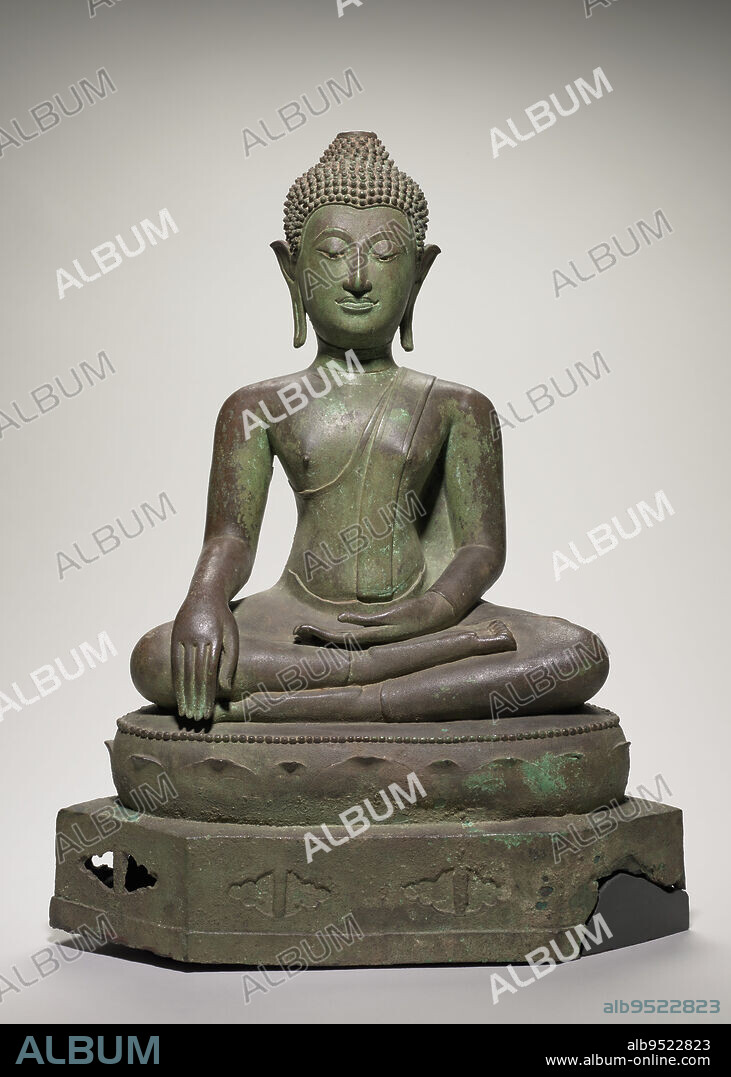alb9522823
Buddha subduing Mara, 15th century, 24 3/4 in. (62.87 cm), Bronze, enamel, Thailand or Laos, Chieng San style, This sculpture captures the moment of the Buddhas enlightenment: the defeat of Mara, lord of the realm of desire and cause of human suffering. In a gesture called bhumisparsamudra, his right hand gently calls the earth to witness the momentous occasion. Thai sculptors often forgo the narrative details of the event; instead, they economically convey its essence. The Buddhas downcast eyes indicate deep meditation, a 'lion-like' body resists the armies of temptation, and the face, now free from suffering, radiates bliss. Likely created in central Thailand, the sculpture demonstrates how Thai artists frequently fused regional tastes. Its lotus-cushion throne and broad shoulders reflect developments in the northern Thai kingdom of Lan Na (12001700), while the oval head, U-incised chin, heart-shaped hairline, and tubular limbs reflect developments in the southern Sukothai Kingdom (12381438).

|
Añadir a otro lightbox |
|
Añadir a otro lightbox |



¿Ya tienes cuenta? Iniciar sesión
¿No tienes cuenta? Regístrate
Compra esta imagen.
Selecciona el uso:

Descripción:
Ver traducción automática
Buddha subduing Mara, 15th century, 24 3/4 in. (62.87 cm), Bronze, enamel, Thailand or Laos, Chieng San style, This sculpture captures the moment of the Buddhas enlightenment: the defeat of Mara, lord of the realm of desire and cause of human suffering. In a gesture called bhumisparsamudra, his right hand gently calls the earth to witness the momentous occasion. Thai sculptors often forgo the narrative details of the event; instead, they economically convey its essence. The Buddhas downcast eyes indicate deep meditation, a 'lion-like' body resists the armies of temptation, and the face, now free from suffering, radiates bliss. Likely created in central Thailand, the sculpture demonstrates how Thai artists frequently fused regional tastes. Its lotus-cushion throne and broad shoulders reflect developments in the northern Thai kingdom of Lan Na (12001700), while the oval head, U-incised chin, heart-shaped hairline, and tubular limbs reflect developments in the southern Sukothai Kingdom (12381438).
Crédito:
Album / quintlox
Autorizaciones:
Tamaño imagen:
4824 x 6754 px | 93.2 MB
Tamaño impresión:
40.8 x 57.2 cm | 16.1 x 22.5 in (300 dpi)
 Pinterest
Pinterest Twitter
Twitter Facebook
Facebook Copiar enlace
Copiar enlace Email
Email
